Table of Content
The laughing Buddha is viewed as a representation of joy, prosperity, satisfaction, and welfare. Statues of the Laughing Buddha are seen to be auspicious and are frequently kept in homes, workplaces, hotels, and restaurants for luck and good vibes. Continue reading to learn more about the meaning of the Laughing Buddha and how to display it in your home.
Laughing Buddha: Meaning
The statue known as the giggling Buddha depicts a small, pot-bellied guy with a happy expression on his face. These statues are seen as representations of joy, abundance, and fortune. Because of this, statues of the laughing Buddha are very common as part of home décor. These statues consistently feature a smiling Buddha with a bag of food and other goodies. Laughing Buddha sculptures exist in a variety of shapes, and each one represents a different idea, such as happiness, family love, or other qualities, in addition to luck, success, and money.Laughing Buddha: History
The person shown in the statues and paintings of the laughing Buddha is a Chinese Zen monk by the name of Budai. He lived in the latter half of the Liang dynasty, between 907 and 923 AD. He was known as the "laughing Buddha" because of his compassionate nature and perpetually cheery smile. He was regarded by some Buddhist traditions as the coming Buddha or "Bodhisattva Maitreya."Laughing Buddha statue: Significance
The statue of the laughing Buddha serves as a reminder to be thankful, push through challenges, and most importantly, enjoy life. According to the Feng Shui philosophy, buying and putting statues in the home is done to address a certain life imbalance. Vastu Shastra practitioners promoted the placing of laughing Buddhas in homes even though it is a Feng Shui emblem. The god of wealth Kubera and the laughing Buddha are comparable. Indians therefore relate it to wealth. According to Vastu, choosing a laughing Buddha statue for your home and putting it in the northeast corner is lucky.Laughing Buddha: Real name
According to Chinese mythology, the laughing Buddha is a representation of the 'Budai', or Chinese Zen monk. This monk was a native of Fenghua and went by the Buddhist name Qieci (Pinyin).Laughing Buddha statue: Popularity and prevalence
At their doorways, laughing Buddha sculptures are a common sight at Chinese temples. The 24.6 m-tall laughing Buddha statue, which is made of camphor wood and covered in 60 taels of gold, is a famous feature of the Lingyin temple in Hangzhou. The largest wooden statue in China is this one. Statues of the Laughing Buddha are also offered as gifts in gift stores and on the grounds of temples and monasteries all around the world.Types of laughing Buddha and their meaning
You can decorate your home with a variety of laughing Buddha statues. Here is a list containing each type's definition and importance.Types of laughing Buddha #1: Laughing Buddha with a sack or bag
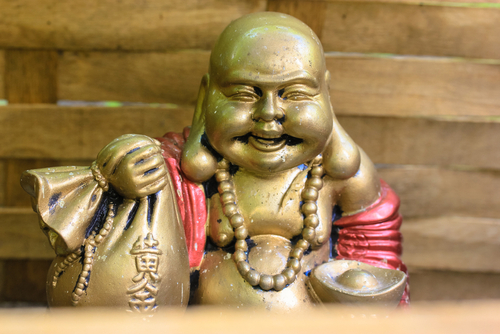 The sack represents how the smiling Buddha collects one's anguish and suffering, stuffs them within his sack, and then provides one abundance and positivity. The bag also stands for money and luck.
The sack represents how the smiling Buddha collects one's anguish and suffering, stuffs them within his sack, and then provides one abundance and positivity. The bag also stands for money and luck.
Types of laughing Buddha #2: Laughing Buddha holding beads
 Meditation is symbolized by the beads. The beads are symbolic of wealth and success. Other interpretations include the fruit peach or apricot, which stands for health, or pearls of wisdom.
Meditation is symbolized by the beads. The beads are symbolic of wealth and success. Other interpretations include the fruit peach or apricot, which stands for health, or pearls of wisdom.
Types of laughing Buddha #3: Laughing Buddha sitting on a gold nugget
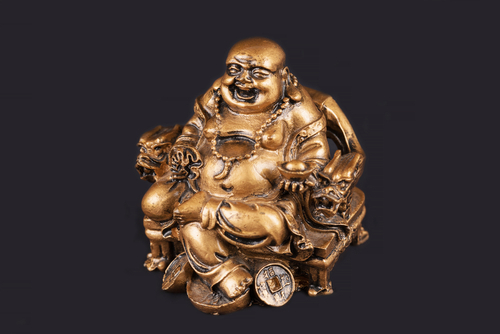 This statue of the laughing Buddha handing a tiny golden nugget while perched atop a large one represents the Buddha granting good fortune. This statue will shield you from bad energy and spread positive vibes.
This statue of the laughing Buddha handing a tiny golden nugget while perched atop a large one represents the Buddha granting good fortune. This statue will shield you from bad energy and spread positive vibes.
Types of laughing Buddha #4: Laughing Buddha with a fan and wu lou
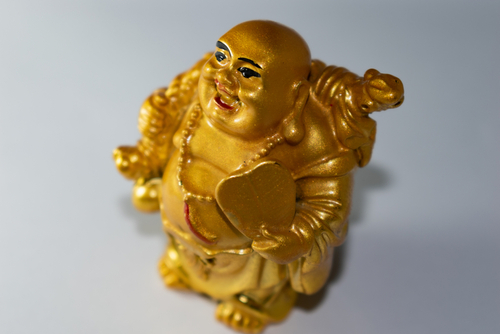 Blessings and good health are bestowed by the statue of a laughing Buddha holding a fan in one hand and a wu lou (bottle gourd) in the other. The bottle gourd guards against illness while the fan wards off bad luck.
Blessings and good health are bestowed by the statue of a laughing Buddha holding a fan in one hand and a wu lou (bottle gourd) in the other. The bottle gourd guards against illness while the fan wards off bad luck.
Types of laughing Buddha #5: Laughing Buddha with a hat
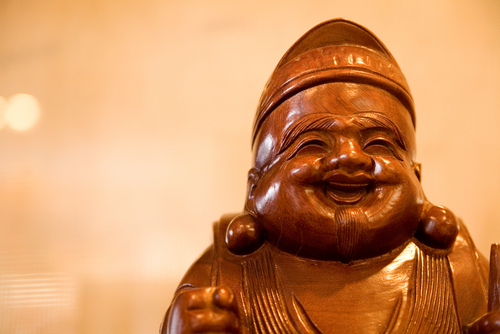 This monument represents a long, fulfilling, healthy, and carefree life. Keep this figurine to banish problems and to be granted joy, happiness, and a life free from worry.
This monument represents a long, fulfilling, healthy, and carefree life. Keep this figurine to banish problems and to be granted joy, happiness, and a life free from worry.
Types of laughing Buddha #6: Laughing Buddha holding a gold ingot with his hands upright
 This gesture represents wealth and luck. This stance is thought to draw blessings from above, prosperity, and plenty of luck for one's endeavors.
This gesture represents wealth and luck. This stance is thought to draw blessings from above, prosperity, and plenty of luck for one's endeavors.
Types of laughing Buddha #7: Laughing Buddha with a bowl
 The smiling Buddha holding a bowl symbolizes a monk who dedicates his life to enlightenment and the happiness of others. The bowl represents receiving luck, pleasant vibes, and enlightened knowledge.
The smiling Buddha holding a bowl symbolizes a monk who dedicates his life to enlightenment and the happiness of others. The bowl represents receiving luck, pleasant vibes, and enlightened knowledge.
Types of laughing Buddha #8: Laughing Buddha surrounded by children
 The happiness of the family is symbolized by this statue of the laughing Buddha. To solve child-related issues, this figurine is also maintained in the home. It enhances general health and fertility.
The happiness of the family is symbolized by this statue of the laughing Buddha. To solve child-related issues, this figurine is also maintained in the home. It enhances general health and fertility.
Types of laughing Buddha #9: Laughing Buddha sitting on dragon tortoise
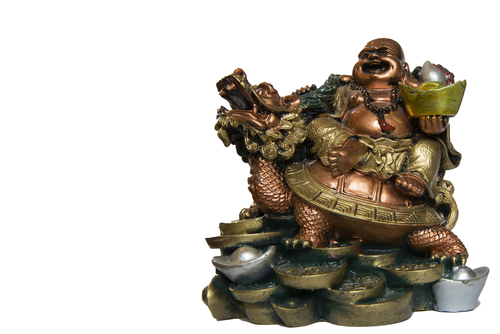 This statue represents a successful career. It implies that one won't ever experience educational obstacles. The turtle and dragon are symbols of stability and strength, respectively.
This statue represents a successful career. It implies that one won't ever experience educational obstacles. The turtle and dragon are symbols of stability and strength, respectively.
Types of laughing Buddha #10: Meditating laughing Buddha
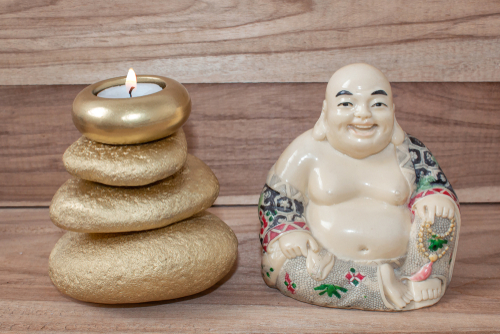 Choose a statue of a laughing Buddha in meditative bliss for a quiet and tranquil life. By doing this, you'll be able to handle any tension you encounter and experience peace.
BUY NOW - Petrichor Resin Fengshui Figurine Laughing Buddha
Choose a statue of a laughing Buddha in meditative bliss for a quiet and tranquil life. By doing this, you'll be able to handle any tension you encounter and experience peace.
BUY NOW - Petrichor Resin Fengshui Figurine Laughing Buddha
How to choose Laughing Buddha for home?
The Laughing Buddha ideal for you depends on why you want to get it. Here are a few things which will help you choose the best laughing buddha for your house.- For boosting positivity and eliminating misery: Laughing Buddha with a sack or bag
- For bringing good luck: Laughing buddha sitting on a large golden nugget and handing out a smaller gold nugget
- For wisdom and affluence: Laughing Buddha with beads and eyes closed
- For wealth and blessings: Laughing Buddha with a fan and bottle gourd.
- For happiness and healthy: Laughing buddha with a hat
- For attracting prosperity and wealth: Standing laughing buddha with an ingot over its head
- To eliminate problems related to children: Laughing buddha surrounded by kids
- To pursuit enlightenment: A laughing buddha with a bowl
Laughing Buddha statue: Material
Laughing Buddha statues for home are crafted from various materials, each carrying its own symbolic significance related to the elements of nature. Here’s what each material represents:- Metal: Laughing Buddha statues made of metals like gold, silver, copper, brass or pewter are ideal for attracting improved career prospects and stimulating creativity. They are also beneficial for those seeking to start a new family or embark on a journey.
- Stone: Jade is the most popular stone used for crafting laughing Buddha statues. Jade is associated with luck and good fortune, making a jade laughing Buddha statue ideal for enhancing relationships and promoting good health. It fosters family harmony, knowledge, and personal growth.
- Wood: A wooden laughing Buddha statue helps attract both health and wealth. Placing it in the family sector of your house promotes harmonious relationships and overall well-being for your loved ones. Additionally, positioning a wooden Buddha statue in your office can attract a favourable reputation and fame.
Laughing Buddha statue: Posture
- The sitting posture of the laughing Buddha is considered to be that of love and it symbolises the stability of thoughts and tranquillity.
- The standing Buddha symbolises treasure and happiness.
Why is laughing Buddha lucky?
It's said that maintaining the happiness of a laughing Buddha statue in your home is crucial. Rumor has it that you can accomplish this by rubbing his tummy. A laughing Buddha statue's belly is said to bring wealth, luck, and success when touched.Laughing Buddha statue for home: Things to avoid
- One should never place the statue in the kitchen, bathroom or toilet.
- Never keep the statue on the floor directly. The statue should be placed at least at eye level.
- Always keep the area around the statue clean and clutter-free.
- Avoid placing the statue near electrical outlets, motors, or above any electronic appliance as it can disturb or block the aura of good energy.
- Never keep the laughing Buddha above a shoe rack.
FAQs
Which direction should a laughing Buddha statue face in a home?
The laughing Buddha can be placed in the east, south-east or north-east direction of the home, or opposite to the main entrance, facing the inside of the house.
Is Laughing Buddha good or bad?
The laughing Buddha is believed to be a lucky charm that brings wealth, prosperity and health.
Is laughing Buddha a god?
It is believed that the laughing Buddha figurine is a depiction of Budai, a Chinese monk from the 10th century.
Can I keep a laughing Buddha statue in the garden?
One can place a laughing Buddha in the garden but ensure that it is not placed on the ground directly. Keep it on a tray or a stool and the statue should face the east direction.
Is laughing Buddha the same as Gautam Buddha?
Laughing Buddha is not the same as Gautam Buddha. Laughing Buddha is a Chinese monk who was a patron saint of children, while Siddharth Gauatma is the prince of Kapilavastu and the founder of Buddhism, who is known as Buddha, the enlightened one.
How many laughing Buddha statues can I keep at home?
There is no specific number in Feng Shui, regarding keeping laughing Buddha statues at home. Each statue suggests something that can harmonise various aspects of your life. Nevertheless, it is better not to keep too many statues and to place them in the correct direction to attract positive energy.
Can I keep laughing at Buddha in the car?
One can hang or display a laughing Buddha on the front dashboard of the car. It signifies taking away of worries and bringing of joy. It can also be a form of protection for a safe journey.
What does the Baby Buddha monk statue signify?
Little Laughing Buddha Statue or monk figurine the adorable little Buddha is in trend in home decor. It signifies good fortune, peace and happiness, These cute statues come in various colours and poses such as reading, meditating, dancing, speaking no evil, hearing no evil gestures etc.
Which pose represents ‘Happy Buddha’?
The Standing Buddha represents ‘The Happy Buddha’ and is said to bring wealth and happiness, into your home. This pose is also called Jolly Hotei since he is laughing with his hands lifted above his head in celebration.
What are the different names of the laughing Budha?
The Laughing Buddha has become a popular name for Budai, a Chinese, Buddhist Zen monk. He is also known as Fat, chubby and Happy Buddha or Budai (Chinese) or Hotai (Japanese). He is also called Pu-Tai (Budai), which means ‘hempen sack’ which he always had with him full of goodies, such as sweets for children.

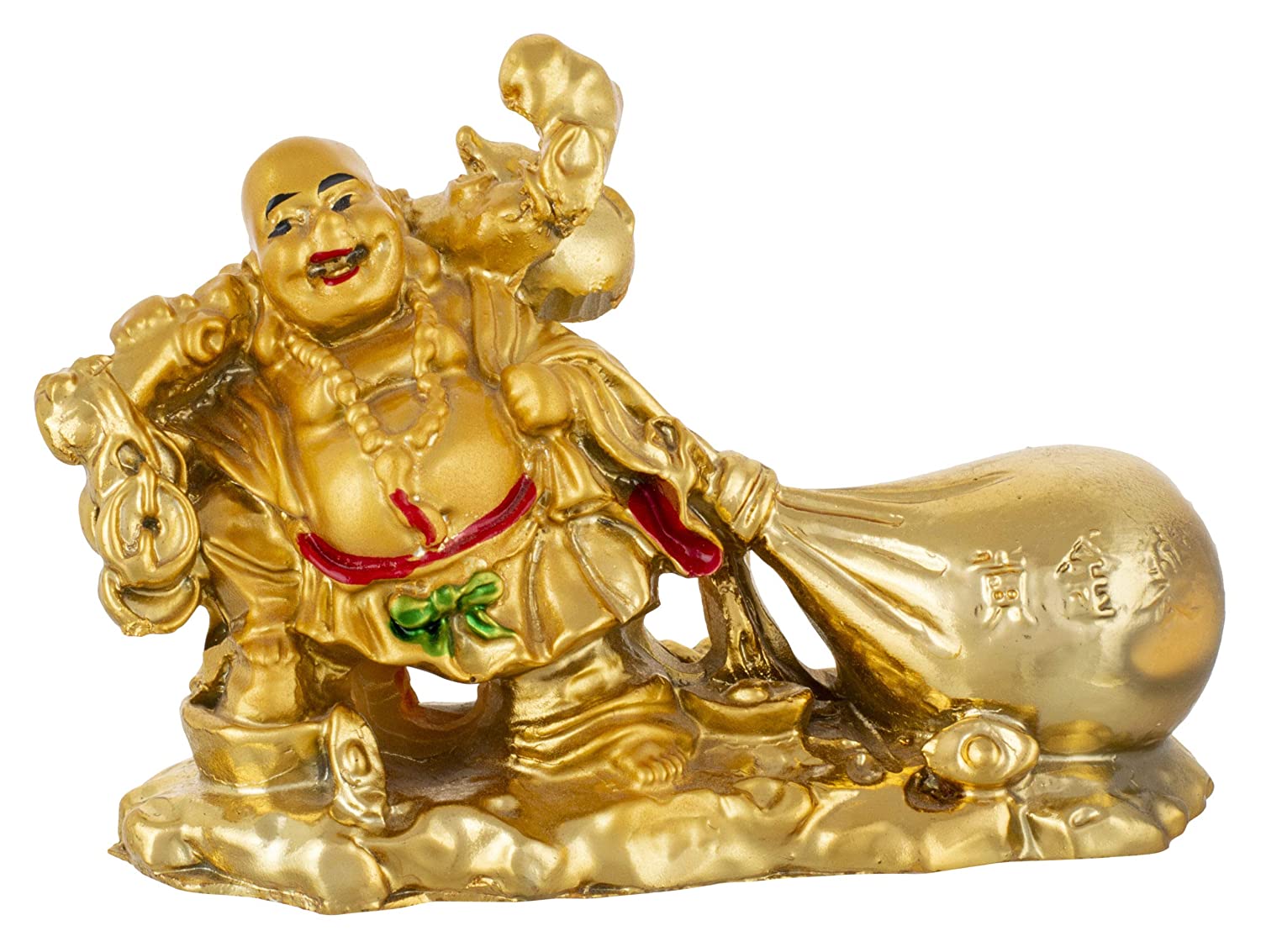
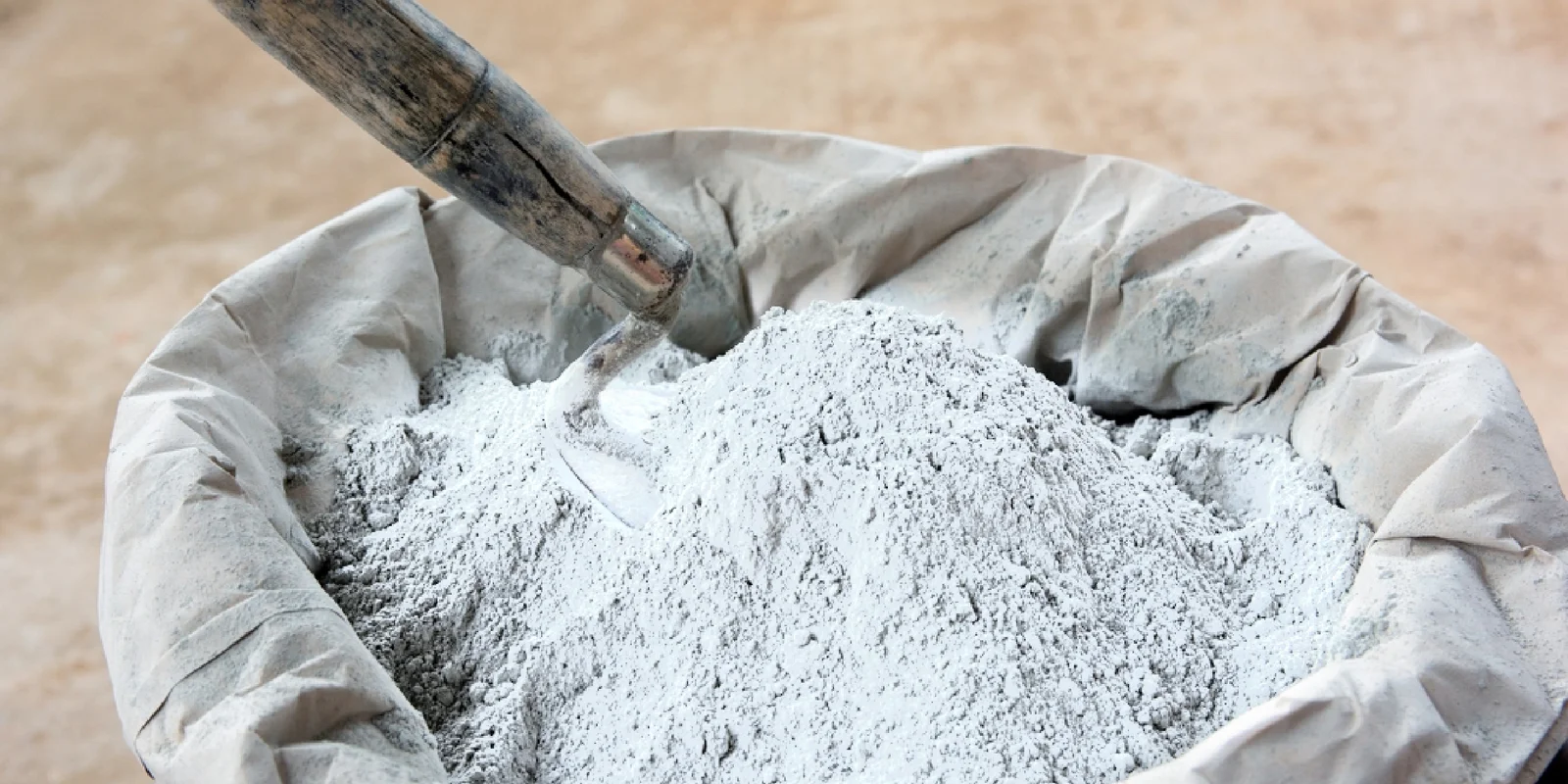








_1766133697.webp)